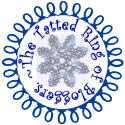"Copytatting" is a newly coined word for working tatting from a photo or finished piece without the pattern. This is a valuable skill. If you can do this, you have developed an understanding of how tatting is constructed. This skill is sometimes invaluable for figuring out patterns with poorly written directions, or for adapting patterns to make them easier to work by employing new techniques. For many, this is a step in learning how to design. But just because you have developed this skill does not mean you should always use it. A locksmith may know how to open various locks without keys, but shouldn't be doing it in the wrong situation. Just as locksmithing should not be used for burglary, copytatting morally should not be used for copyright infringement.
When is copytatting NOT OK?
- If there is a published pattern that you do not have a copy of. Some people say it is OK to copytat for your own personal use, but this is rather like reading a magazine at the newsstand instead of buying a copy. Even if you are not getting income from your tatting, you are depriving the author of the income of a sale.
- If there is a picture available, but no pattern, and you have not received permission. The original tatter who has published/posted a picture, but does not have a pattern available, may wish to produce and sell the pattern at a later date. They may want to be the only one selling items made from their designs, so making your own deprives them of a sale. They may wish to make or sell one-of-a-kind pieces, and unauthorized knockoffs could lessen the value of their work.
- You really, really want to work a pattern, but you can't afford to buy it. I actually see this rationalization online. Oh, come on. If you wanted something in a store and you couldn't afford it, would you just take it? Well, some people would, but it's not right. If you can't afford to buy patterns, that's too bad, but it's not a good excuse. There are more free patterns and public domain patterns posted online than a person could work in a lifetime, so go find some of those. Also, tatters tend to be very generous people. If you make friends, sometimes they will give you gifts you can't afford yourself.
- You can't find a copy of the pattern book. Just keep trying. Between ebay and used book sellers, you may get a copy later. Meanwhile, tat something else.
When is copytatting OK?
- If there is a piece of vintage tatting, and a thorough search has been made and failed to discover any evidence the pattern was ever published. Example, Georgia's Mystery Doily.
- If there is no published pattern, and the designer is deceased, and the heir has given permission. Example, Lucy Consistre's Rose Doily on Georgia's site.
- I once copytatted Elgiva Nichol's Rococo Heart, with the rationalization that there was no published pattern, and as the designer was deceased, she would not be losing any revenue. I did not ask anyone's permission. Was this acceptable? I don't know. This is a very grey area. Would I do it today? Probably not.
I admit that in my younger (pre- and very early internet) days I did copytatting without thinking much about it. Tatting patterns were rare in those days, and I didn't know how to find books that weren't on the shelf at the bookstore. I was ignorant about the concept of copyright. I don't do it anymore. Nowadays, if you are online to read this, you have the ability to search and locate legitimate sources of patterns for purchase, and the ability to find countless free patterns. I didn't know any better then, but I do now. And if you have read this, or Jane's recent posts, so do you.























































